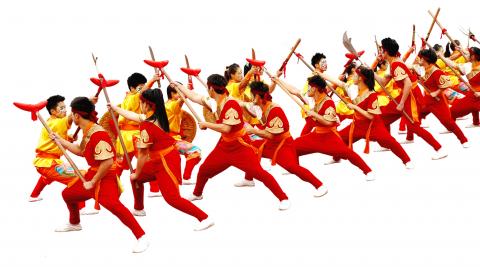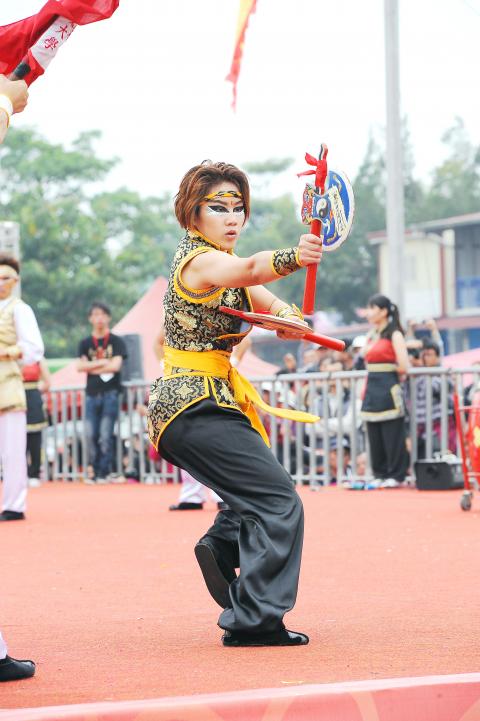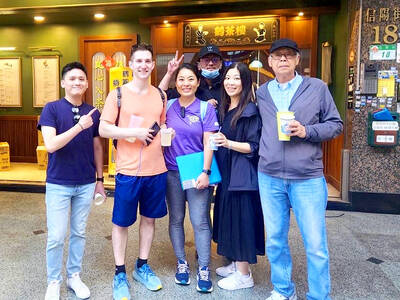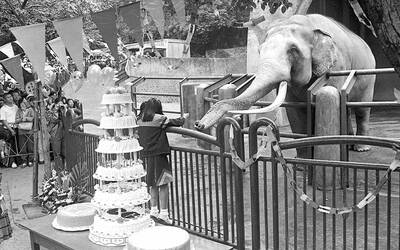This weekend, thousands of martial arts fans are expected to descend on Greater Kaohsiung’s Neimen District (內門) to watch a week-long lineup of Song-Jiang Jhen Battle Array (宋江陣), a form of performing arts that combines elements of kung fu, dance and drumming.
The festival, now in its 12th year, invites martial arts troupes from home and abroad to showcase their best moves. Groups of college students will also take part in a creative competition, which is aimed at revitalizing the tradition.
Originating over a century ago, the battle array was named after Song Jiang (宋江), leader of a group of bandits who lived during the Song Dynasty. In training his henchmen, Song would divide them into two groups and have each person carry a weapon. A round of mock duels would then follow.

Photos Courtesy of Kaohsiung City Government
The method was so successful in preparing the men for battle, it was later adopted as a regular military exercise to boost defense capability and ward off pirates, bandits and neighboring clans. A wide variety of weapons, strategies, formations and music were applied to make the exercise more challenging.
Over the years, the battle array has transformed itself into a ritual that is performed in temples to honor the birthdays of deities. Today, temples in southern Taiwan organize the performance teams themselves. Although a full-size team consists of 107 members, it is more common to see a 72 or 36-member array.
Recognizing that the custom has been slowly dying out, the Kaohsiung City Government, in cooperation with local temples, has been holding a series of activities in Neimen to revive interest in the performance art.

Photos Courtesy of Kaohsiung City Government
“Neimen is a special place … Its population stands at 15,000, but it has 50 to 60 martial arts performance troupes,” said Deputy Mayor Lee Yung-te (李永得) at a press conference held to launch the annual festival.
Many uprisings took place in Neimen in the past, including a large scale anti-Manchu protest led by Chu Yi-kuei (朱一貴) in the early 18th century. Neimen people’s valor and courage both in the past and present contributed greatly to Taiwan’s battle array culture, he said.
Introducing the battle array as an art that integrates sports and music, Lee said that the event is a great way to experience Taiwan’s rich cultural heritage. Photo exhibitions, calligraphy shows and a culinary extravaganza will also be held alongside the performances. Complete details in Chinese and English can be found at: www.who-ha.com.tw.

A vaccine to fight dementia? It turns out there may already be one — shots that prevent painful shingles also appear to protect aging brains. A new study found shingles vaccination cut older adults’ risk of developing dementia over the next seven years by 20 percent. The research, published Wednesday in the journal Nature, is part of growing understanding about how many factors influence brain health as we age — and what we can do about it. “It’s a very robust finding,” said lead researcher Pascal Geldsetzer of Stanford University. And “women seem to benefit more,” important as they’re at higher risk of

Eric Finkelstein is a world record junkie. The American’s Guinness World Records include the largest flag mosaic made from table tennis balls, the longest table tennis serve and eating at the most Michelin-starred restaurants in 24 hours in New York. Many would probably share the opinion of Finkelstein’s sister when talking about his records: “You’re a lunatic.” But that’s not stopping him from his next big feat, and this time he is teaming up with his wife, Taiwanese native Jackie Cheng (鄭佳祺): visit and purchase a

Mother Nature gives and Mother Nature takes away. When it comes to scenic beauty, Hualien was dealt a winning hand. But one year ago today, a 7.2-magnitude earthquake wrecked the county’s number-one tourist attraction, Taroko Gorge in Taroko National Park. Then, in the second half of last year, two typhoons inflicted further damage and disruption. Not surprisingly, for Hualien’s tourist-focused businesses, the twelve months since the earthquake have been more than dismal. Among those who experienced a precipitous drop in customer count are Sofia Chiu (邱心怡) and Monica Lin (林宸伶), co-founders of Karenko Kitchen, which they describe as a space where they

April 7 to April 13 After spending over two years with the Republic of China (ROC) Army, A-Mei (阿美) boarded a ship in April 1947 bound for Taiwan. But instead of walking on board with his comrades, his roughly 5-tonne body was lifted using a cargo net. He wasn’t the only elephant; A-Lan (阿蘭) and A-Pei (阿沛) were also on board. The trio had been through hell since they’d been captured by the Japanese Army in Myanmar to transport supplies during World War II. The pachyderms were seized by the ROC New 1st Army’s 30th Division in January 1945, serving